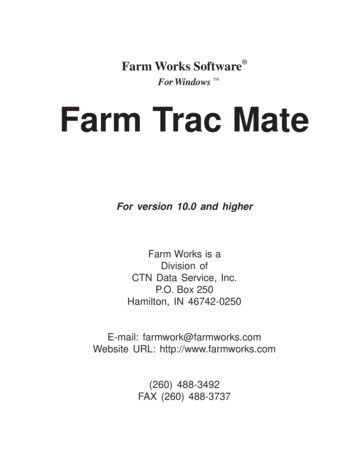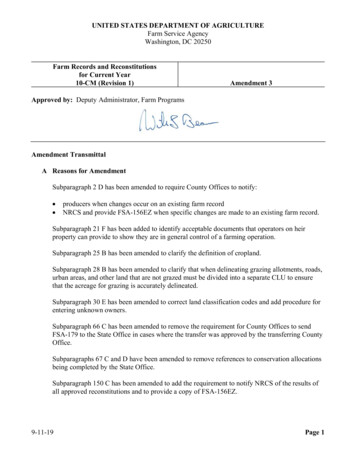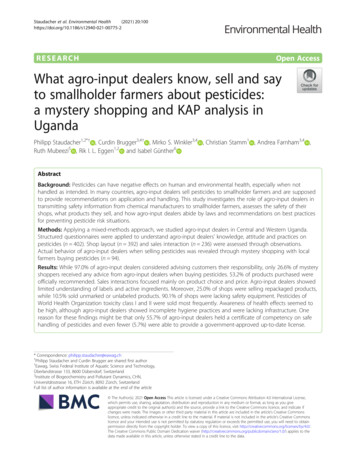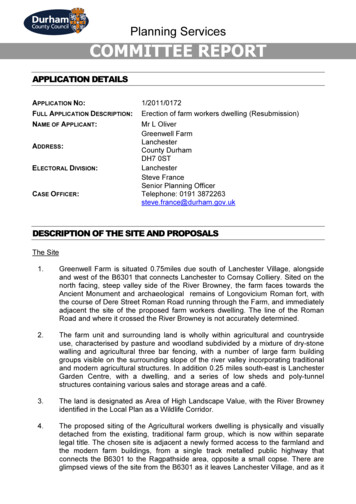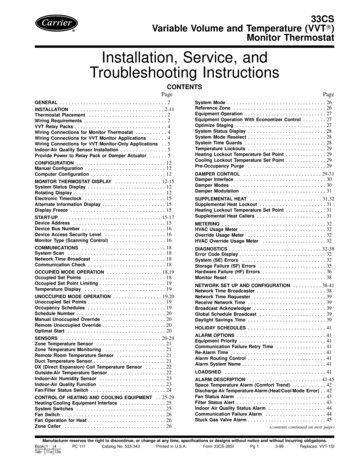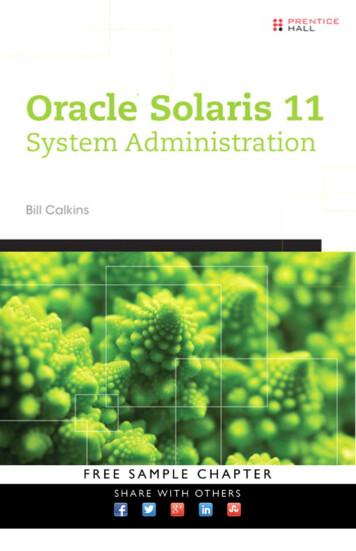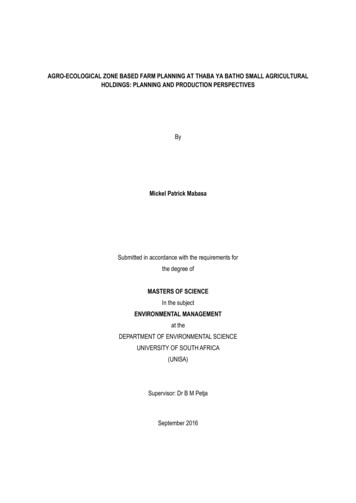
Transcription
AGRO-ECOLOGICAL ZONE BASED FARM PLANNING AT THABA YA BATHO SMALL AGRICULTURALHOLDINGS: PLANNING AND PRODUCTION PERSPECTIVESByMickel Patrick MabasaSubmitted in accordance with the requirements forthe degree ofMASTERS OF SCIENCEIn the subjectENVIRONMENTAL MANAGEMENTat theDEPARTMENT OF ENVIRONMENTAL SCIENCEUNIVERSITY OF SOUTH AFRICA(UNISA)Supervisor: Dr B M PetjaSeptember 2016
DEDICATIONThis dissertation is dedicated to my late father and sister.Johannes Mosesenyane ‘‘Joe Sample’’ Mabasa and Winnie ‘‘Ausi-Tsakane’’ Mabasa.May their soul rest in peace. The race is on.i
ACKNOWLEDGEMENTI am so grateful for the support from my mother (Nyami Christinah Mabasa) for motivating me to study hardthroughout the years.I also extend my gratitude to the following: I thank Dr B M Petja, for supervising this study, guidance and constructive criticism throughout thecourse of the research period. University of South Africa (UNISA) for allowing me to enrol for this post graduate study. Director of Tiji Holdings (Pty) Ltd for encouragement during the years of training. To my cousin, Prof B K Peterson who supported my career path. I extent my heartily thanks to The National Department of Agriculture, Forestry & Fisheries. My deep appreciation goes to my mentors, Mrs Anneliza Collett and Mr Ndifelani Mararakanye forproviding me with the necessary information and their constructive comments and suggestions. To the Almighty Lord for giving me wisdom, strength for making all things possible. My sincerest appreciation to my beautiful daughter for giving me support and encouragement duringlonely hours of study.Lastly, special thanks also go to everyone who participated in this research.ii
DECLARATIONStudent No: 33260982I, Patrick Mickel Mabasa declare that this dissertation, Agro-ecological zone based farm planning at ThabaYa Batho Small Agricultural Holdings: Planning and Production Perspectives is my own work and that allthe sources that I have used or quoted have been indicated and acknowledged by means of completereferences.M P Mabasa.Dr B M Petja30/09/2016Date. 30/09/2016Datei
ABSTRACTThis study assesses agricultural planning and production perspective on smallholder farms of Boschplaats 91 JRusing an integration of a geographic information system (GIS) and remote sensing (RS). The main objective wasto evaluate the use of agro-ecological zoning (AEZ) in planning and its role in promoting sustainable agriculturalproduction on a smallholder farm. This was achieved through processing, analysis and interpretation of satelliteimages together with in situ spatial data for land suitability evaluation. SPOT-5 images, which were acquired from2006 through to 2011 were used to detect change that took place in the study area. Agro-ecological parameterssuch as soil, climate and terrain are limiting factors that would have a negative impact on agricultural production.Soil degradation is also a major problem to food security in Thaba Ya Batho smallholder farms and presentsenvironmental constraints to agricultural expansion. Suitable land that could increase food production wasidentified and mapped. This contributes to delineation of the suitability of the land and demarcating areas of highagricultural potential. The results show that a GIS and RS make it possible to plan and monitor the use of theenvironment on Thaba Ya Batho smallholdings. The analysis of climate, soil and terrain has shown that morethan 80% of the study area is suitable for both irrigated and dryland production. A number of key constraintsfaced by smallholder farmers are presented. Lack of experience and poor agricultural planning were found to beamong limiting factors to production. Despite the scale at which agro-ecological zones are generated, they stillplay significant role in planning of agricultural production.Keywords: Geographic information system, Remote sensing, Agro-ecological zone, Suitability, Planning,Production, Smallholder farmi
GLOSSARY OF TERMINOLOGYAgriculture – Activities associated with the cultivation of land, producing crops and raising livestock that areuseful to human beings.Agro-ecological zoning – Division of an area of land into land resources and mapping units; having uniquecombination of landform, soil, and climatic characteristics and land cover that has a specific range of potentialand constraints for land use.Commercial farmers – Large scale farmers who primarily produce for the market and make a considerableliving from farming.Geographic Information System – A system for capturing, storing, checking, integrating, manipulating,analysing, and displaying data which is spatially referenced to the Earth.Land cover – The vegetation and artificial construction covering the land surface.Land use – Man’s activities on land which are directly related to the land.Planning – A basic management and decision support function involving formulation of one or more detailedplans to achieve optimum balance of resource needs.Production – The process of producing goods and services.Remote sensing – Obtaining information about objects or areas at the Earth’s surface without being in directcontact with the object or area.Smallholder farmers – Small scale farmers, mainly own communal land in former homelands, who produce forhome consumption. They usually occupy an average area of about 7 hectares.Soil auger – A tool for boring holes used for collecting soil samples for analysis.Sustainable development – Development which meets the needs of the present without compromising theability of future generations to meet their own needs.i
ABBREVIATIONSAEZ-Agro-Ecological ZoningAOI-Area of InterestARC-Agricultural Research CouncilCASP-Comprehensive Agricultural Support ProgrammeCBD-Central Business DistrictCBPWP-Community Based Public Works ProgrammeDAFF-Department of Agriculture, Forestry & FisheriesDBSA-Development Bank of Southern AfricaDEA-Department of Environmental AffairsDoA-Department of AgricultureDN-Digital NumberDSMW-Digitised Soil Map of the WorldEIA-Environmental Impact AssessmentEO-Earth ObservationESRI-Environmental Systems Research InstituteFAO-Food and Agricultural Organisation of United NationsGAEZ-Global Agro-Ecological ZoningGLASOD-Global Assessment of Soil DegradationGIS-Geographic Information SystemsGDP-Gross Domestic ProductGPS-Geographic Positioning Systemsha-hectareha/lsu-hectare per livestock unitIPCC-Intergovernmental Panel on Climate ChangeIPGRI-International Plant Genetic Resources InstituteIR-InfraredISCW-Institute for Soil, Climate and Waterii
LADA-Land Degradation Assessment in DrylandsLGP-Length of Growing PeriodsMLM-Moretele Local MunicipalityNDA-National Department of AgricultureNDVI-Normalised Difference Vegetation IndexNLC-National Land CoverNW-North West ProvinceRS-Remote SensingSARD-Sustainable Agriculture and Rural DevelopmentSDWG-Smallholder Development Working GroupStatsSA-Statistics South AfricaSOTER-Digitised Global Soil and Terrain DatabaseSPOT-Système Pour I’Observation de la TerreWADSCO-Water and Dam Services CompanyWCED-World Commission on Environment and Developmentiii
TABLE OF CONTENTSCHAPTERPAGECHAPTER 1: arch problem21.4Aims and objectives21.5Significance of the study21.6Hypothesis3CHAPTER 2: LITERATURE REVIEW42.1Introduction42.2Background to agro-ecological zoning42.3Agro-ecological zone: A global perspective52.4Farming operations in South Africa82.5The role of a GIS and Remote Sensing92.6Integration of the GIS and RS102.7Satellite images as a tool for agricultural planning162.8Sustainable agricultural management and production suitability in smallholder farms182.9The impact of climate change on agricultural production202.10Constraints facing smallholder farmers in Thaba Ya Batho212.11Summary23CHAPTER 3: ENVIRONMENT OF THE STUDY AREA243.1Location243.2Climatic condition253.3Land use253.4Land cover263.5Hydrology293.6Socioeconomic factors293.7Summary31i
CHAPTER 4: MATERIALS AND METHODS324.1Introduction324.2Research design324.3Sampling strategy and field data collection334.4Laboratory analysis334.5Satellite data acquisition344.6Digital image processing354.7Data analysis384.8Summary39CHAPTER 5: RESULTS AND DISCUSSION405.1Introduction405.2Field survey405.3SPOT-5 data classification475.4Land cover505.5Integration of GIS products515.6Agro-ecological zones description565.7Delineation of agricultural potential zones575.8Crop production model635.9Summary65CHAPTER 6: CONCLUSION AND 666.3Suggestions for future research68REFERENCES69ii
LIST OF FIGURES2.1Three pillars of sustainable development183.1The geographic location of the study area in North West province, South Africa243.2Topographic map of Thaba Ya Batho273.3Grass cover in Eragrostis plana-Cyperus rupestris273.4Water sources in Thaba Ya Batho293.5The presence of major roads in Thaba Ya Batho303.6A) Waste disposal, (B) Red yellow soils and (C) fresh vegetables314.1Location of soil samples and farm units334.2Google Earth imagery of Thaba Ya Batho Smallholder Farms364.32006 Subset imagery using SPOT374.42008 Subset imagery using SPOT375.1The effects of pH on soil nutrient availability (K, Ca, Mg and Na)425.2Data transformation depicting Ca (mg/kg)435.3Data transformation depicting Mg (mg/kg)445.4Data transformation depicting k (mg/kg)445.5Annual rainfall (mm) for the period 2009-2013465.62011-2006 (land cover change-detection image 20%)485.7Satellite-derived NDVI in Thaba Ya Batho, 2006 and 2010485.8Supervised classification created using SPOT imagery 2006/2009495.9Land Cover Classification for Thaba Ya Batho, 2000505.10Soil suitability for irrigation map535.11Suitability for irrigated vegetables555.12High potential agricultural land585.13Land capability of the study area595.14Growing season for most summer crops615.15Division of land use63i
LIST OF TABLES2.1Scales of land-use planning and management62.2Major agricultural land-use in South Africa per million (ha)82.3SPOT imagery features163.1Land utilisation in North West Province (1991)263.2Land use and land cover in Moretele264.1Soil with beneficial water retaining layer284.2SPOT-5 data used in Thaba Ya Batho334.3Weather station344.4Data types and parameters for agricultural land assessment in Thaba Ya Batho345.1Key priority factors are based on physical observation395.2Types of water resources in Thaba Ya Batho based on 12 randomly selected plots405.3Soil type description415.4Monthly temperature (minimum and maximum) in ºC for the period 2009-2013455.5Monthly rainfall figures (mm) for the period 2009-2013465.6Agro-climate indices in Thaba Ya Batho475.7Land-cover characteristics of mapped areas in Thaba Ya Batho515.8Legend of generalised soil patterns of Thaba Ya Batho525.9Soil potential for irrigation525.10Detailed description of soil suitability for irrigation535.11The terrain of Thaba Ya Batho smallholder farms545.12River545.13Suitability for irrigated vegetables555.14Vegetation555.15Grazing capacity (ha/lsu)565.16Land-cover classes and descriptions565.17Land suitability for agriculture585.18Cropping patterns for field crops in Thaba Ya Batho605.19Production season in Thaba Ya Batho615.20Recommendations for pest control and fertilizers625.21Distribution of land use65ii
APPENDIXAPPENDIX A:FIELD SURVEY IN THE STUDY AREA75APPENDIX B:CHEMICAL SOIL PROPERTIES OCCURING IN THE STUDY AREA(SOIL DEPTH 20-60 CM)76APPENDIX C:CROP REQUIREMENTS78i
CHAPTER 1INTRODUCTION1.1 IntroductionThis study explores the role and effectiveness of agro-ecological zoning (AEZ) in sustainable agriculturaldevelopment as a planning tool within a rural setting. Cloete et al. (2009) demonstrate that sustainableagricultural development enhances agricultural planning and production. It describes effective ways ofaddressing agricultural planning problems experienced on small agricultural holdings. Sustainable agriculturalproduction can only be achieved when agriculture meets the needs of the present generation withoutcompromising the ability of the future generation to meet their own needs. Ngqangweni & Hendriks (2003)identifies rural agricultural development as a priority for the South African government.Sustainable farming has the potential to improve human livelihoods. Petja et al. (2014) indicate that sustainableagriculture and rural development (SARD) practices have the potential to reduce hunger and poverty whilesustaining the ecosystem that poor rural people rely on for livelihood. Schulte et al. (2014) emphasize thatsustainable food production has re-emerged on top of the global policy agenda which is driven by the twocontemporary challenges, namely the challenge to (1) produce enough food to feed a growing world populationand (2) make more efficient and prudent use of the world’s natural resources; including water, atmosphere, soil,nutrients and the natural heritage in the form of biodiversity. Food production is problematic in many parts ofSouth Africa due to land degradation. As a result of water scarcity, yield decreases.Geographic information systems (GIS) are mostly used to determine the relationship between soil, topographyand land use/cover when assessing the land potential (Sivakumar & Hinsman, 2004). The use of remote sensingand GIS is limited in rural areas due to limited resources. SPOT-5 imagery is a suitable tool to be used inproviding information on land cover and use. It produces the remote sensing images that could assist inassessing land cover changes across large areas at regular intervals (Simms, 2009). This study explores highresolution satellite images from SPOT-5 in order to identify suitable areas for production potential for smallholderfarms in Thaba Ya Batho.1.2 BackgroundFarming is not only important in South Africa, human survival depends on it. It provides safe food everyindividual. Agriculture is the main source of income on smallholder farms. Baloyi (2010) emphasises thatsmallholder farms generate self-employment opportunities and improve the standard of living within the localcommunity. Moreover, smallholder farming is important for food security.1
This study was undertaken at Thaba Ya Batho smallholder farmers on the farm portion Boschplaats 91 JR. Likemany other smallholder farmers in South Africa, Thaba Ya Batho smallholders have not performed well in termsof agricultural production. In recent years agricultural output has declined due to poor farm planning andmanagement although the area is located on high potential agricultural land. Thaba Ya Batho smallholder farmunder-perform due to lack of capacity for sustainable agricultural development. Other constraints faced bysmallholder farmers include lack of access to markets, finance, communication, infrastructure, education, andskills training (Department of Agriculture, Forestry & Fisheries [DAFF] (2012). Low levels of education alsoimpact on the agricultural sector in rural areas as it becomes difficult for the farmers to understand theenvironmental management needed in order to achieve high levels of agricultural production. Environmentalfactors such as water and land use have a considerable impact on agricultural production.1.3 Research problemA Thaba Ya Batho smallholder farm experiences environmental risks such as erosion, fire and waste, bushencroachment and land degradation which makes agricultural production difficult. There are many farm plots thatare unproductive because of poor management. This results in the establishment of grass and bushencroachment. This condition is a result of lack of land use planning and poor farming practices that degrade thesurrounding land. Other factors such as lack of experience in agriculture and environmental monitoring limitproduction. Currently agriculture provides little income for the households and subsistence agriculture dominates.Smallholder agriculture is diminishing over time as a result of poor planning which results in limited production.Consequently, other farming plots in Thaba Ya Batho are left unoccupied as a result of migration to urban areas.However, part of the study area is characterised by favourable and conducive agricultural environments. Thisstudy experimented with AEZ for use in farm-scale production planning. Many models of AEZ are based onprovincial, national, and regional scales. The AEZ model is demonstrated in a site-specific (smallholder farm)area to examine its applicability.1.4 Aim and ObjectivesThe main aim of the research is to evaluate the use of AEZ in planning and its role in promoting sustainability ona smallholder farm. The specific objectives are to:1.4.1Identify, classify and describe agro-ecological zones of the study area;1.4.2Use remote sensing technology to do spatial analysis of the change detection maps;1.4.3To identify and assess production limiting factors;1.4.4To encourage sustainable agricultural development as an important source of food production; and1.4.5To assess and characterise the agro-ecological potential of the study area.2
1.5 Significance of the studyThis study seeks to encourage agricultural planning for production on rural farms. Thaba Ya Batho smallholderfarms are examples of such farmers that require a comprehensive agricultural plan for risk management andefficient production. In order to meet the demand for food, the zoning of sustainable agricultural utilisation ofsmallholder farms is very important. The objective of the zoning is to identify areas with different potential andassess constraints for development. This is done to enable sustainable utilisation of land. The study area isvulnerable to human impact, such as dumping, fire, fuel wood collection and inappropriate land use. For planningpurposes, the outcomes of the study will transform farming on smallholder farms and increase sustainableproduction. The study will provide a unique means of understanding the state of agricultural planning through theuse of geo-informatics. It will also create an agro-ecological zone map of Thaba Ya Batho. The AEZ provides aneffective base to support land use, planning and management. Sustainable agricultural development is thecritical issue to be addressed in order to revitalise smallholder farms.1.6 Hypothesis1.6.1Agro-ecological zoning enables decision support for agricultural production and planning.1.6.2The AEZ approach could overcome existing agricultural problems in Thaba Ya Batho.1.6.3AEZ can be optimally determined by integrating GIS and RS to identify and map out potential sites foragricultural production.3
CHAPTER 2LITERATURE REVIEW2.1 IntroductionThis chapter provides the literature review of key themes of relevance to the study. It starts with background andan explanation of AEZ. The background information about smallholder farming in both global perspective andSouth African context is presented in this chapter. This chapter also explores the concepts of sustainabledevelopment on smallholder farms. The challenges faced by smallholder farmers are discussed as well. Theapplications of GIS and RS on smallholder farm evaluation are also explained.2.2 Background to agro-ecological zoningAgro-ecological zoning (AEZ) refers to the division of an area of land into land resource mapping units,displaying a unique combination of landform, soil and climatic characteristics and/or land cover with a specificrange of potential and constraints for land use. AEZ can be regarded as a set of core applications leading toassessment of land suitability and potential (Patel, 2004). According to Kurukulasuriya & Mendelsohn (2008),AEZ plays a vital role in dividing a heterogeneous landscape into a set of homogeneous zones. The Food andAgricultural Organisation of the United Nations (FAO) (2005) points out that AEZ has a great potential as a basisfor policy-level decision making and could be used as a basis of a legal framework for land zoning. Studies haveshown that AEZ as applied in the FAO methodologies, defines zones on the basis of the combination of soil,landform and climatic characteristics (FAO, 1993). Accurate zoning has the potential to assist in the site selectionprocess (Rogan & Chen, 2004). Jensen (1996) describes AEZ as the strategy that can meet the challenges ofpoor planning and destruction or deterioration of the environment.Araya et al. (2010) indicate that proper AEZ and classification help policy makers, investors and agriculturalist todrive crop suitability and amend the existing limitations to cropping, as well as to plan for better short- and longterm development strategies under climate change scenarios. Williams et al. (2008) indicate that AEZ identifiesfundamental geographic units that provide information on location and extent of crop-relevant resources and theircapabilities and potential for future use as part of strategic planning. It is very important for smallholder farms tounderstand the environmental factors and their impacts on production capacity.Literature indicates that the AEZ methodology started in 1975 (FAO, 1996). The methodology has been used toaddress various questions related to soil inventory, land evaluation, land use planning and management, landdegradation assessment and land use mapping at global, regional, national and subnational levels (FAO, 2005).Many models of AEZ are based on the FAO methodologies which characterise the physical factors associatedwith suitability of various crops in a specific environment.4
Wandahwa & van Ranst (1996) indicate that sustainability can be expressed in terms of highly suitable;moderately suitable; marginally suitable; unsuitable with or without the possibilities for land improvements. In thecase of this study, zoning aims to demarcate the high potential areas for future use. Collett (2008) finds thatzoning for agricultural use provides the opportunity to create areas where farming would be the only land useallowed. Recently, there has been a major focus of AEZ methodology used for specific locations. The resultsfrom many studies show that agro-ecological innovations are necessary to develop a new and truly sustainableagriculture that reverses environmental deterioration and at the same time augments the supply of food (de laRosa et al., 2009). Agro-ecological zoning was applied in land degradation assessment of dry lands (LADA). Onthis issue, it should be mentioned that land degradation affects the world’s agricultural land, especially indeveloping countries (The National Department of Agriculture [NDA], 2005). On the other hand, there are majorlimitations to global agro-ecological zoning (GAEZ). Fischer et al. (2006) indicate that the Global Assessment ofSoil Degradation (GLASOD) offers insufficient details and quantification for application within the GAEZ model.Therefore, Fischer et al. (2006) propose the need for further validation of the results underlying the databases.Xuegong et al. (2006) indicate that most of the existing studies deal with the general sustainable development forthe whole country, and few focus on zoning of agricultural sustainability.2.3 Agro-ecological zone: A global perspectiveThis review draws on experience from studies conducted in other countries. Several studies have shown theapplication of AEZ at global, national, district and sub-district levels. A review of the literature indicates that theFAO has been assessing various countries such as Mozambique, Kenya, Nigeria, Brazil, China and Nepal,applying and adapting the methodology to local level (FAO, 1996). The AEZ methodology was first applied on aglobal scale in assessing food production potential and population-supporting capacities in developing countries,using a 1:5 million scale FAO soil map of the world (Table 2.1). A global digital AEZ land resources databasecalled global agro-ecological zones 2000 (GAEZ) was developed using the digitised soil map of the world(DSMW), the digitised global soil and terrain database (SOTER) and digitized global climate databases (FAO,2005).The study conducted by Fischer et al. (2006) finds that agro-ecological zoning follows an environmentalapproach which provides a standard framework for characterisation of climate, soil, and terrain conditionsrelevant to agricultural production. Crop modelling and environmental matching procedures are used to identifycrop-specific environmental limitations under assumed levels of input and management conditions. It is,therefore, necessary to argue that the scale used by the FAO is not sufficient to make a decision at farm level.The FAO indicates that GAEZ provides a global inventory of agro-climates, soil and terrain conditions, andevaluations of land resources potential and constraints, and productivity possibilities for more than 250combinations of crop and management level. The FAO has developed a technique for inventory, evaluation andplanning of land resources, both at global level and in regions and developed countries.5
Table 2.1:Scales of land use planning and managementLevel of analysisField or productionUnit (site-specific)ScaleIssuesProductive crops and animals; conservation of soil andwater; high levels of soil fertility; low levels of soil and waterpollutants; low levels of crop pests and animal diseases.Farm or village1:1 000 - 1: 50 000Viable production systems; satisfaction of food(local)requirements, economic and social needs; awareness byfarmers.Country (national or 1:25 000 - 1:2 500 000Judicious development of agro-ecological potential and usesubnational)of irrigation water resources; drought and flood risks; foodproduction and food security; conservation of naturalresources and biodiversity, carbon sequestration; landdegradation; public awareness.Continent or world1:1 000 000 - 1:5 000 000 Land degradation and desertification; preservation of(regional or global)biodiversity; water sharing; water pollution; populationdevelopment and food security; climate change andagricultural potential and carbon sequestration ofagricultural heritage systems; awareness of regional andglobal institutions.Source: Adopted from FAO (2005)2.3.1 1:50 000Food and Agricultural Organisation of the United Nations (FAO) AEZ modelThe FAO developed a GIS model, linking it with its agro-ecological zoning and similar models, to tackle issues ofland, food and people at global, national and subnational levels. Much of the work on AEZ has been performedby the FAO to improve food security in developing countries (FAO, 2005). The zones were intended to capturethe length of the growing season taking into account soil moisture (Kurukulasuriya & Mendelsohn, 2008). Thefirst series output of the FAO AEZ project covered land suitability estimations for crops at three levels of inputs infive regions of developing countries (1996). Studies conducted show that land suitability evaluation includes theassessment of both land potential for selected crops and water potential of the area (Neamatollahi et al., 2012).The study conducted by Fischer et al. (2006) demonstrates that an AEZ approach is a GIS-based modellingframework that combines land evaluation methods with socioeconomic and multiple criteria analysis to evaluatespatial and dynamic aspects of agriculture. The study further highlights that the results of global agro-economiczoning include the identification of areas with specific climate, soil and terrain constraints to crop production;estimate of the extent and productivity of rain-fed and irrigation cultivable land and potential for expansion; andimpacts of climate change on production, geographical shifts of cultivable land (FAO, 2005). The FAO (1996)shows that the GAEZ database has been used in global land productivity studies for estimation of arable landpotential for agricultural expansion by country. Several studies indicate that more than three quarters of theglobal land surface area is unsuitable for crop cultivation with severe constraints such as cold climate, dryclimate and steep topography (Neamatollahi et al., 2012).6
It is therefore, not surprising that the FAO has used global agro-ecological zoning in regional and country studieson land use changes, population support capacity and land suitability for agriculture (FAO, 1993).The key elements applicable to the AEZ proposed by the FAO (1996) can be summarised as follows: Land resources inventory; Inventory of land utilisation types and crop requirements; Land suitability evaluation; Potential maximum yield calculation; and Matching of constraints and requirements.Reviewing the results of GAEZ, the FAO (1996) proposes that the methodology characterises tracts of land byquantified information on climate, soil, and other physical factors, which are used to protect the potentialproductivity of various crops according to their specific environmental and management needs. The methodologyof the FAO is analysis of various problems of land resources for planning and management at national, regionaland subnational levels (FAO, 1996). The results of many studies have shown that AEZ is used globally to assesscrop suitability (Fischer et al., 2006). Many countries have carried out their own AEZ studies that deliver usefulapplications and results (Wandahwa & van Ranst, 1996).2.3.2AEZ in developing countries: Kenya and UgandaUganda and Kenya have similar smallholder farmers as South Africa. The AEZ national studies in Kenya andUganda have used length of a growing periods (LGP) pattern as a means of capturing inter-annual variation(FAO, 1996). Kenya was used as a case study to develop and test the upgraded AEZ methodology for detailedcountry assessment. In Kenya the AEZ study involved analysis at district level. SPOT-5 imagery was used forvegetation data to determine the net primary production. The vegetation biomass was used to predict the cattlecorridor (Makuma-Massa et al., 2012).Kenya and Uganda are affected by water scarcity. The population relies on subsistence agriculture. Smallholderfarmers i
Land cover - The vegetation and artificial construction covering the land surface. Land use - Man's activities on land which are directly related to the land. Planning - A basic management and decision support function involving formulation of one or more detailed plans to achieve optimum balance of resource needs.
